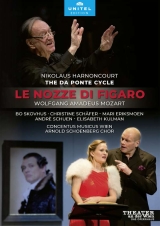Der vor fünf Jahren verstorbene Nikolaus Harnoncourt hat quasi als sein Vermächtnis die halbszenische Aufführung der drei Da Ponte Opern von Mozart in Wien noch ausgeführt. Davon liegt als erste Einspielung jetzt die Hochzeit des Figaro vor. Dass Harnoncourt auch bei Mozart-Opern zum Experten wurde und hohe Authentizität erreichte, überrascht nicht. Welche Mühen es machte, so ein Projekt zu stemmen, ist der Aufnahme nicht zu entnehmen.
Das beinahe einstündige Bonusmaterial lässt sich als Einführung auch vor der Oper ansehen und man kann aus den dort gesammelten Stichpunkten die Intensität und Akribie, aber auch allseitige Freude bei der Vorbereitung erahnen. Harnoncourt und die Sänger bereden bei ihm zu Hause – auch ein Hinweis auf die enge, fast familiäre Zusammenarbeit – speziell den Aspekt, wie die Rezitative zu gestalten sind. Seine kompetenten Ausführungen sind auch für die meisten Sänger bereichernd, die private Atmosphäre macht es entspannt. Wer Musik nur als Nebensache sieht, wird hier nicht bereichert. Aber andächtig Lauschende erfahren viel über Funktion und Wichtigkeit der Rezitative bei Mozart. Dabei kann man feststellen, dass gestaltete und ernsthaft vorgetragene Rezitative alles andere als langweilig sind. Das bietet auch uns danach bei der Aufführung Verständnisvorteile.
Dann taucht der Betrachter in ein überzeugendes Ergebnis ein, das nur in Nuancen Raum nach oben lässt. Notenpulte bzw. Partituren stehen für die Sänger bereit, einige kommen ohne diese Unterstützung aus. Alle agieren zumindest mimisch. Statt der nüchternen Bühnenrückwand wird eine Galerie gezeigt, in der Porträts der Sänger in Kostüm und Maske hängen. Sie treten jedoch in Alltagskleidung. Die Fokussierung auf das Wesentliche bekommt der Aufführung sehr gut, was über das Fehlen der üblichen Zutaten zur Oper hinwegtröstet.
Nikolaus Harnoncourts Lesart ist sehr persönlich und bestens durchdacht. So muss man sich an seine Tempi gewöhnen. Gleich die Ouvertüre lässt er so langsam musizieren, dass sie vergleichend fast schleppend wirkt. Doch das bietet die Gelegenheit, überall neue Details zu hören und die scheinbar so bekannte Musik noch mal neu zu justieren. Er bringt dazu, Farben und Ecken in der Partitur zu entdecken. Der von Harnoncourt gegründete Concentus Musicus ist von Beginn an geeicht, begleitet ausgesprochen subtil, lässt die Sänger mit der Musik atmen.
Noch mal zur Bedeutung der Rezitative: Um die Bedeutung des Textes zu unterstreichen, lässt er die meisten rezitativen Passagen deklamieren und nur gelegentlich singen. Diese interessante Technik wird weitgehend souverän gemeistert. Hier fällt leider Andrè Schuen auf, der ansonsten einen stimmlich perfekten Figaro mit schönem Timbre anbietet. Mari Eriksmoen als Susanna ist der zweite Teil des frischen jungen Paares; tadellose Diktion und heller Sopran sind die perfekte Ergänzung.
Christina Schäfer gibt der Gräfin eine in ihrer gesellschaftlichen Rolle gefestigte Dame, Probleme werden hinter den Fassaden ausgetragen. Schöne Phrasierungen zählten zu ihren großen Stärken. Sie wirkt geringfügig unsicher.
Bo Skovhus, einer der Höhepunkte der Sängerriege, hingegen lebt die Rolle des Grafen vollständig aus. Souverän und schneidig, auch verschmitzt, agierend, schwächelt seine Stimme lediglich in den unteren Lagen leicht. Beeindruckend singt er seine Arie, die durch Harnoncourts Unterstützung bei Gewicht und Akzent sehr an Flexibilität gewinnt. Weiter heraushebenswert ist Elisabeth Kulman als Cherubino.
In den weiteren Rollen Peter Kalman als Bartolo mit Flair und Farbe. Ildiko Raimondis singt die Marcellina mit viel Empfindung. Die Barbarina wird von Christina Gansch mit ihrer Ausstrahlung und einer schönen Stimme prägend dargestellt.
























